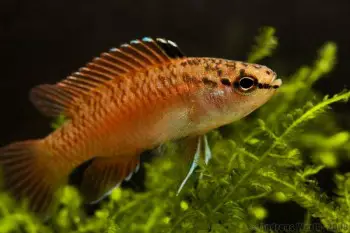New Dario wears makeup
The previously unidentified badid known to aquarists as Dario sp. ‘Jaintia Hills’ or D. sp. ‘Bangladesh’ is described by ichthyologists Dr. Ralf Britz and Dr. Sven Kullander in today’s issue of ‘Zootaxa’.
It is named Dario kajal with the specific name derived from the Hindi word kajal, meaning ‘black eyeliner’ as per that used by traditional Indian dancers, in reference to the prominent dark orbital stripes.
The description brings the total number of species in the genus to five, of which four are considered miniature species since they do not exceed 26 mm in standard length (SL).
The fifth, D. urops, not only grows larger, to at least 28.0 mm SL, but occurs in southwestern India whereas the others are native to the Brahmaputra, Meghna, and Ayeyarwaddy river systems in northern India, Myanmar, and southwestern China, and this raises interesting questions regarding their biogeography.
D. kajal can be told apart from its congeners by colour pattern as follows: possession of a dark postorbital stripe that continues behind the eye in line with the preorbital stripe, versus postorbital stripe forming an oblique angle with the preorbital stripe (D. dario and D. urops) or postorbital stripe absent (D. hysginon and D. dayingensis); males with a series of bars arranged in pairs in the upper half of the body, versus bars extending across the entire body (D. dario), bars complete but restricted to the posterior portion of the body (D. urops) or bars absent (D. hysginon and D. dayingensis).
In addition it differs from D. urops by not possessing, versus possessing, either a blotch on the caudal peduncle or a horizontal suborbital stripe , by males possessing dorsal-fin lappets which extend beyond the tip of the spine, versus not extending beyond the tip of the spine, and having only 24–26, vs. 28–29, vertebrae.
It can be distinguished further from D. urops and D. dayingensis in possessing 8, versus 9-10, transverse scales and absence, versus presence, of palatine teeth, from D. dario by possessing, versus lacking, a black anterior spot in the dorsal fin and modally 7, versus 6, anal-fin rays, and from D. hysginon by the absence, versus presence, of an anguloarticular lateral line canal.
D. kajal is currently known only from the type locality, a tributary within the Myntdu River system in the Jaintia Hills region of Meghalaya state, northeastern India, although the authors suggest that since the river flows on into Bangladesh D. kajal may also occur there.
The type series was collected by Andrew Rao of Malabar Tropicals, Calcutta, and British Danio expert Peter Cottle in 2006.
For further information download the full, open access paper: Britz, R. and S. O. Kullander, 2013. Dario kajal, a new species of badid fish from Meghalaya, India (Teleostei: Badidae). Zootaxa 3731(3): 331-337.
Matt Ford
Category: New Species, News | Tags: Dario, Ralf Britz, Sven O. Kullander, Zootaxa | Comment »




Site improvements
thanks
21st Jan 2025
Site improvements
This is an excellent post, glad you shared it. I just stumbled upon your blog and have enjoyed reading your posts.
14th Jan 2025
Site improvements
This is an excellent post, glad you shared it.
14th Jan 2025
Product reviewers wanted
Are you still looking for product reviewers?
19th Dec 2024
Product reviewers wanted
Hey! Interesting article!
17th Dec 2024